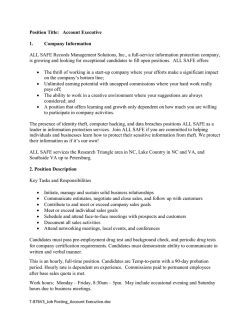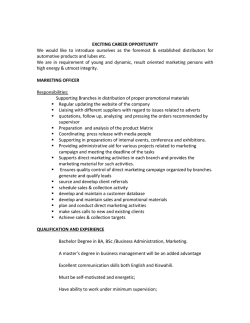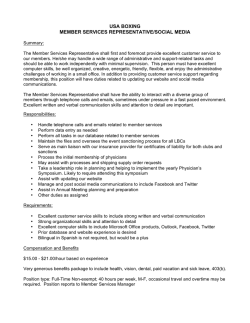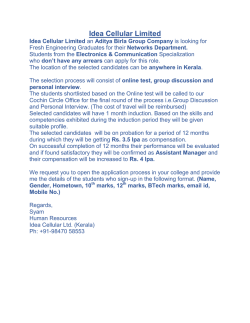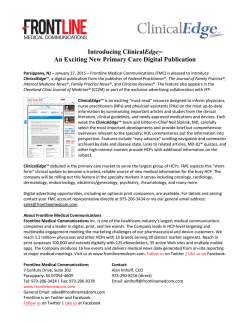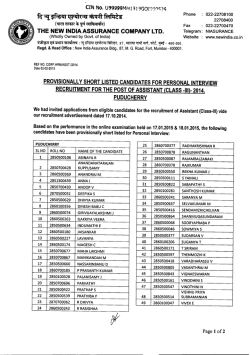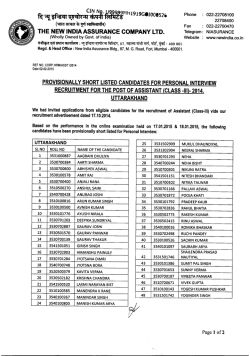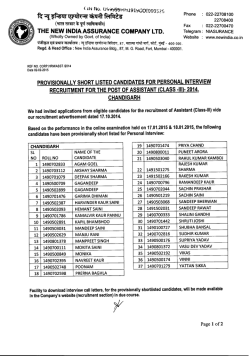
`New` vs `old` leaderships: the campaign of Spanish general
Guillermo López-García [email protected] Associate Professor. Journalism Studies. Language Theory and Communication Sciences Department. Faculty of Philology, Translation and Communication. University of Valencia. Spain. Submitted March 27, 2016 Approved May 24, 2016 © 2016 Communication & Society ISSN 0214-0039 E ISSN 2386-7876 doi: 10.15581/003.29.3.149-168 www.communication-society.com 2016 – Vol. 29(3), pp. 149-168 How to cite this article: López-García, G. (2016) ‘New’ vs ‘old’ leaderships: the campaign of Spanish general elections 2015 on Twitter. Communication & Society 29(3), 149-168. ‘New’ vs ‘old’ leaderships: the campaign of Spanish general elections 2015 on Twitter Abstract The focus of this research is to analyze the activity on Twitter, during the campaign for the 2015 general elections in Spain, of the leaders of the main Spanish political parties: Mariano Rajoy (PP), Pedro Sánchez (PSOE), Pablo Iglesias (Podemos) and Albert Rivera (Ciudadanos). That means: how many messages and what types of messages are published; what topics they focus on; and the main features of using Twitter: to spread political messages, reference candidate activities in the media or on the campaign trail or emphasize personal aspects. The methodological approach establishes three complementary areas: a) a quantitative analysis of the tweets published by the four candidates throughout the election campaign, focused on establishing the percentage of responses and retweets; b) a content analysis to determine the issue agenda of each candidate; and c) a qualitative analysis that allows us to provide an overview of the communication preferences and profile of each candidate. The combined results of this triple methodological approach show that candidates from emerging parties tend to send messages to mobilize their supporters to campaign and to make generic announcements regarding their future victory and the arrival of political change, while the leaders of PP and PSOE tend to publish more messages with specific policy proposals. Keywords Political communication, Twitter, electoral campaigns, agendasetting, social networks 1. Introduction: an open, mediatized campaign The 2015 general elections in Spain generated a truly unprecedented amount of attention and interest among both the media and the general public. There were various reasons for this, but we would like to highlight two. First, these were the first general elections in the history of Spain’s current democracy to feature four major political choices. Spain’s democratic election model took root in the country only in 1977, the year of the first democratic elections following the death of 149 ISSN 2386-7876 – © 2016 Communication & Society, 29(3), 149-168 López-García, G. ‘New’ vs ‘old’ leaderships: the campaign of Spanish General Elections 2015 on Twitter Francisco Franco, and went on to take the shape of a two-party system with significant minority parties: UCD and PSOE as the two major parties and AP and PCE as the primary alternatives. Nonetheless, AP and PCE won far fewer votes than the two major options. Moreover, from that moment on, the two-party system would only further establish itself and increase its dominance. Not even UCD’s collapse in 1982 would jeopardize the two-party system. Rather, it was simply replaced by AP. Nor should we interpret the PSOE’s decline prior to the 2011 general elections as a break from the two-party system. Although the party was weakened, it still had better results (28% of the popular vote and 110 seats) than any alternative party, such as Izquierda Unida (“United Left”, evolution of the PCE, 7% of the popular vote and 11 seats) or UPD (just under 5% and five seats). This situation remained largely the same during Mariano Rajoy’s (of the People’s Party or PP) first years as prime minister. Electoral support fell for both the PP and the PSOE, but this did not lead to a corresponding increase in support for either IU or UPD, two parties which were unable to challenge the PP and PSOE’s dominance in any electoral contest (such as the regional elections in Andalusia, Asturias, Galicia, Catalonia or the Basque Country in 2012). Things began to change with the 2014 European Parliament election and the emergence of Podemos [literally, We Can], which took place during an unusual collapse of the two-party system (Boix & López, 2014). This change would solidify itself several months later, with the rise of Ciudadanos (Citizens) and several opinion polls that showed a very level playing field with no clear leader. In this context of uncertainty, it seemed that any of these four parties, the classic PP and PSOE and the emergent Podemos and Ciudadanos, could aspire to win the elections. Indeed, it would seem so until practically December 20, 2015: Election Day. Along with an incipient electoral scenario that we could appropriately label as “fourparty”, a second factor helped to raise interest in these elections: the media as intermediaries and as actors in the process itself (Graber, McQuail & Norris, 2008; Castells, 2009). In this way, we mean not only the media dimension of the campaign but also the very evolution of the political scenario, which was very dependent upon the media in general and television in particular. The leaders of the new parties (Pablo Iglesias of Podemos and Albert Rivera of Ciudadanos) owe much of their success, and certainly their public visibility, to their media appearances. The media, for their part, began to see that news and, above all, political analysis and opinion, had become a gold mine for information and audience share. In just two years, political talk shows, which until then had been mostly limited to obscure channels and times, became prime time events. The new leaders made a name for themselves on such programs, and we should even recognize that, at least in the case of Podemos, they built their political projects into a viable option through their media presence (Domínguez & Giménez, 2014: 15). The marked mediatization of the campaign, which would come to delineate the political arena and provide it with new players, is not limited to television. The written press also fuels the process, especially through polls and frameworks centered on the same ideas: who can win and what new options are arising. Of course, there is also the new media: online information outlets and social networks. A great deal of the former (El Diario, Infolibre, Vozpópuli, ctxt, etc.) are dedicated to political news, and social networks represent a constant flow of messages that combine political news, analysis and opinion, revolving around the appearance of politicians in the traditional media outlets. Lastly, this scenario shows a clear rise of individual leadership figures in the face of traditional party structures and, in short, is accentuating the process of individualization that has been dominant ever since TV became the main medium for political information (Mazzoleni, 2010). 150 ISSN 2386-7876 – © 2016 Communication & Society 29(3), 149-168 López-García, G. ‘New’ vs ‘old’ leaderships: the campaign of Spanish General Elections 2015 on Twitter 2. The new communications environment and Twitter’s role in election campaigns The scenario we’ve outlined corresponds with a communications environment characterized by overlapping media and a large variety of disparate communicators. Alongside traditional media we also see social networks, party candidates, opinion leaders from other spheres (journalists, social activists, professors, artists, etc.). In this context, information flows arrive from different, very diversified, sources, but the mainstream media still maintain a central position. Chadwick (2013) has labelled this communications environment a hybrid system. That is, it is a system in which there are old and new media that feed off one another. In such a system, the public may continue to consume traditional media, but they may do so at consumption rates quite different from those of just a few a years ago (Jenkins, 2008). News cycles are shortened and intensified, and news almost always start in the traditional media. Nonetheless, it then spreads and often has unexpected offshoots on the web and on social networks (Chadwick, 2013: 44). In his research, Chadwick provides distinct examples of how this hybrid system works, many of them related to electoral processes. From these examples we can infer that, despite the profound changes undergone in the communications environment, the major media institutions are still the same as in the previous communications model. That is, the major media outlets are the ones that set the agenda, direct the public’s attention and influence society. Furthermore, they continue to do so despite the implication that they must evolve and adapt to the new environment by generating online versions of traditional media whose content is similar to that of the traditional source. (Chadwick, 2013: 86-88). This process is particularly clear in the case of television. It also seems clear that TV continues to exert an incomparable influence on society, and this perception becomes especially clear in light of Spain’s experience. Nonetheless, TV’s influence has no effect in isolation, nor has it ever. Its ability to focus the public’s attention depends on many players and particularly on the extent to which social commentary on TV content reverberates. This is where the Internet, and social media in particular, play a crucial role (Claes & Deltell, 2015). Our research here is centered on the hybrid media system described by Chadwick (Casero, Feenstra & Tormey, 2016), but whose characteristics were ordered systematically several years ago (Castells, 2009: 92-186) and predicted even as far as two decades ago (McLuhan, 1996). We focus on the role of social networks, and of Twitter in particular, and analyze how the candidates of the major political parties use their Twitter accounts. That is, the accounts of Mariano Rajoy (PP), Pedro Sánchez (PSOE), Pablo Iglesias (Podemos) and Albert Rivera (Ciudadanos). We have chosen to focus our attention on Twitter instead of other social networks for various reasons. On one hand, Twitter is open to the public and a message’s potential to spread depends not only (not even mainly) on the number of followers a particular account has, but also on the exponential reach of the messages retweeted by the same followers or the possibility of reaching innumerous others if the message becomes a trending topic. The way Twitter works has a great deal in common with the traditional media’s process of agenda setting (Rubio, 2014). Twitter, unlike any other social network, allows the user to set his agenda and establish which messages will be prioritized, in addition to allowing him to determine their order of appearance and subject matter. It also particularly corresponds with the communications reality brought on by this new environment, one that is characterized by the reduction of the news cycle and its fragmented broadcasting to the public, in an often decontextualized manner (Barber, 2004: 38). 151 ISSN 2386-7876 – © 2016 Communication & Society 29(3), 149-168 López-García, G. ‘New’ vs ‘old’ leaderships: the campaign of Spanish General Elections 2015 on Twitter During the campaign season, Twitter can be a powerful tool for political parties. It is an issue that academia has already begun to study (Giansante, 2015). Worldwide there are already many important studies related to electoral processes in a variety of countries, for example: the United States (Hendriks and Kay, 2010), Italy (Ceron & d’Adda, 2015; Vaccari & Valeriani, 2015), France (Mercier, 2015), Belgium (D’Heer & Verdegem, 2014) and Holland (Vergeer & Hermans, 2013), among many others. In fact, it is such a productive field that there are even compilations of the most important contributions (Vergeer, 2015). Despite utilizing a variety of approaches and methodologies, as is to be expected, the majority of these analyses tend to have one thing in common: the political leaders’ clear recycling on Twitter of the communication strategies that were common in the preexisting media context. In other words, their messages are largely unidirectional, determined by the argumentative lines of the party itself and directed at the party’s audience (members and sympathizers). Furthermore, the messages feed off and often refer to one another. Needless to say, the conclusions are not unanimous, given that they also depend on how politicians adapt to Twitter—a constant process—or the context being analyzed. For example, some studies seem to show that affinity between politicians and the people they represent and their desire to interact with them increase in smaller communities that are more accustomed to participatory democracy practices, as is the case in Norway (Larsson & Ihlen, 2015). In Spain, too, there are various studies that deal with the use of Twitter during election campaigns. Gámir (2016) shows a complete map of activity on social networks (Twitter among them) by the leaders of the PP and the PSOE in each contest during the 2011 General Elections. Criado, Martínez-Fuentes and Silván (2012) analyze the use of Twitter in the 2011 municipal elections by candidates for the office of mayor in a sampling of municipalities. In their study, in order to determine the communicative success of the candidates, they examine the link between a municipality’s size (which naturally increases both the target audience and the potential interest in the candidates’ tweets), on one hand, and the candidates’ previous online literacy, that is, his ability to use different online platforms (such as blogs, online chats or YouTube videos) and connect with the public, on the other. In another study on the use of Twitter in the 2011 Municipal Elections, which was also extended to cover the General Elections of that same year, Izquierdo (2012) observes that the candidates’ actual interaction with the public is quite low, due not only to the candidates’ inability or lack of desire to respond, but also to the public’s lack of interest in engaging them to being with. The levels of interaction fall even further if we exclude the journalists who use Twitter to obtain statements from politicians. We also consider Zamora and Zurutuza’s study (2014) on the PP and PSOE candidates’ use of Twitter during the 2011 General Elections. The researchers reach the conclusion that both candidates reproduce their party’s traditional political discourse on Twitter—a prefabricated, unilateral discourse with hardly any interaction at all. We also find such conclusions in other research regarding the same case study (Aragón et. al., 2013). As a whole, these studies paint a picture that supports the idea that politicians have scarcely adapted to the dynamics of Twitter. Nonetheless, there are other studies (García Ortega & Zugasti, 2014; Zugasti & Sabés, 2015) that, despite sharing this general conclusion, detect a desire on the part of both candidates to respond to the people who ask them questions on Twitter. Furthermore, this entails an interesting side effect: the candidate ends up discussing a wider variety of topics and strays from the arguments and issue agenda set by the campaign strategy. More recently, we see various studies dealing with the 2014 European Elections that also allow us to better frame our present research. The first study, by Congosto (2014), brings to light a very interesting phenomenon regarding the community of users who pay attention to the politicians’ campaigns. According to Congosto, there are two clearly 152 ISSN 2386-7876 – © 2016 Communication & Society 29(3), 149-168 López-García, G. ‘New’ vs ‘old’ leaderships: the campaign of Spanish General Elections 2015 on Twitter differentiated spheres. One is a collection of endogenous followers, that is, those who belong to the sphere of the candidate’s party (members, public officials, etc.), who undertake to answer and reinforce the messages in a (logically) partisan fashion. The other is a much less defined and coherent exogenous sphere, a group of “normal” users, part of the non-politicized public that pays sporadic attention to the politician’s messages, and whom we can reasonably assume to be, in electoral terms, the primary target of the latter. Lastly, we should refer to one of our own studies, also regarding the European Parliament in Spain (López-García et al., 2015), which focuses on the Twitter accounts of the leaders of eight political parties in Spain. The study combines various research methodologies and reaches conclusions that we consider important and that, in fact, serve as a starting point for our subsequent research: we observed significant differences, both in terms of the form and the content of the messages, between the candidates of “new” parties (Podemos, Ciudadanos, Vox) and those of traditional parties (PP, PSOE, IU). The campaign focused on domestic issues (despite the elections being for the EU Parliament) and lent a great deal of importance to developments in the candidate’s media-political agenda, that is, campaign events and appearances in the media. 3. Research approach: hypothesis and methodology This study focuses on the Twitter activity of the leaders of the four political parties that obtained the best results in the December 20, 2015 General Elections: Mariano Rajoy (PP), Pedro Sánchez (PSOE), Pablo Iglesias (Podemos) and Albert Rivera (Ciudadanos). The study’s main objective is to compare and contrast each candidate’s profile throughout the campaign season: how many and what kind of messages are published; the main issues in the messages; and the major reasons for which the candidates use this social network: to disseminate political messages, to mention the candidate’s media activities, to highlight campaign events or to emphasize personal attributes. The collection of the sample takes place over the entirety of the election campaign, in addition to the day of reflection (the eve of the elections), Election Day and the day after. We extend the data collection period several days beyond the end of the campaign season itself so as to be able to collect the candidates’ main reactions to the results and the subsequent political situation. In total, the sample consists of 1,938 tweets.1 The initial hypothesis is that there will be greater levels of activity, response and discursive variety in the case of the two candidates from the emergent parties (Podemos and Ciudadanos) when compared to the candidates of the traditional two-party system (PP and PSOE). This hypothesis is based on the results of previous research (López-García et al., 2015; López-García, Cano & Argilés, 2015) carried out during other electoral processes, based on a similar methodological approach and conducted by the same R&D group. Moreover, the present analysis is presented within the framework established by this core group.2 The methodological approach establishes three complementary axes: I wish to publicly thank my partners from the Mediaflows R&D group (www.mediaflows.es) José Gámir, Lorena Cano, Germán Llorca, Tomás Baviera and Dafne Calvo, for their help in collecting and compiling the candidates’ tweets. 2 R&D+i Project (Research and Development plus innovation) “Los flujos de comunicación en los procesos de movilización política: medios, blogs y líderes de opinión” [Communication flows in political mobilization process: media, blogs and opinion leaders] (ref. CSO2013-43960-R), directed by Guillermo López-García (Associate Professor of Journalism at the University of Valencia in Spain). A project of the state program R&D+I, established for the period of 2014 to 2016. 1 153 ISSN 2386-7876 – © 2016 Communication & Society 29(3), 149-168 López-García, G. ‘New’ vs ‘old’ leaderships: the campaign of Spanish General Elections 2015 on Twitter a) A quantitative analysis of the tweets published by the four candidates over the course of the electoral campaign that will distinguish between original tweets directed towards the community of Twitter users as a whole, retweets and responses to other users. b) A content analysis that seeks to determine the issue agenda of each candidate. This analysis will focus exclusively on the candidates’ own tweets and will exclude retweets and responses. It will comprise 770 tweets published by the four candidates. The codification manual establishes four principal categories, in keeping with Patterson’s typology (1980, cited in Mazzoleni, 2010): - Policy issues: specific policy issues in healthcare, education, the economy, etc. The candidates’ proposals and evaluations centered on a specific part of the government’s actions. - Political issues: issues regarding the more abstract sphere of electoral contests: party and candidate ideology, alliances between parties, relations with civil society and the powers that be. We also include everything related to vote-counting, potential winning formulas and predictions made by experts or found in opinion polls. - Campaign issues: issues related to the development of the election campaign: campaign events, configuration of party lists and candidacies, campaign strategies, campaign videos and so on. - Personal issues: issues related to the candidates’ lives and activities, their character, hobbies, etc. These four categories contain a much longer list of 64 possible topics of interest (see Annex), which we categorize in order to clarify and homogenize the results of the content analysis. The primary objective of the latter is to determine each candidate’s priorities and objectives in using Twitter and what type of strategy they correspond with. c) A discourse analysis that seeks to provide an overall view of each candidate’s preferences and communications profile. This analysis is based on the sequential reading of the candidates’ tweets and their relationship with the development of election campaign. It will attempt to identify overarching tendencies and exemplify them by highlighting some of the candidates’ most significant or archetypal tweets. Through this combination of methodologies, we aim to provide an overview as broad and complete as possible, in order to properly test our initial hypothesis. 4. Results The results of the analysis yield data that we consider important to our field. Furthermore, they should at least be considered novel, given the specific situation that we are analyzing and our initial hypothesis. In other words, what shape does the electoral contest between the leaders of the traditional parties and those of the emergent parties take? Let’s have a look at the analysis broken down into the complementary methodological approaches described earlier. 4.1. Quantitative analysis: the candidates’ tweets in numbers Speaking quantitatively, we find two complementary measures: first, the candidates’ quantitative popularity and influence, determined above all by the number of followers, and second, their specific activity during the campaign, calculated by the number and type of tweets sent (tweets, retweets and mentions). The table below summarizes these two measures. Although we should be cautious with this initial data and resist the temptation to draw conclusions from them, in terms of the candidates’ popularity we can indeed verify some characteristics that we had already seen under similar circumstances (López-García et al., 2015): a candidate’s popularity on Twitter is not systematically linked to how long he has 154 ISSN 2386-7876 – © 2016 Communication & Society 29(3), 149-168 López-García, G. ‘New’ vs ‘old’ leaderships: the campaign of Spanish General Elections 2015 on Twitter been a member of the social network, nor to how active he is on it. Although both of these factors can be important for anonymous users, and they might partially explain the success of some users who have gained a great deal of fame and impact, in terms of public figures who use Twitter there are more important factors. To a certain degree, we could be seeing a transfer of popularity to Twitter from other spheres. That idea seems to be verified, at least when it comes to the fact that the candidate who has been on Twitter the longest (Pedro Sánchez) and the candidate who tweets the most out of the four (Albert Rivera) have the smallest number of followers. Table 1. The Candidates’ Activity on Twitter Account Initial activity Followers as of Dec 12, 2015 Followers as of Dec 22, 2015 Tweets as of Dec 12, 2015 Tweets Retweets Mentions Total tweets between Dec 12 and Dec 21, 2015 Rajoy @marianorajoy 9/15/2011 1.004.591 Sánchez @sanchezcastejon 8/26/2009 211.932 Iglesias @Pablo_Iglesias_ 11/11/2010 1.344.061 Rivera @Albert_Rivera 2/5/2010 409.932 1.052.480 238.869 1.429.112 452.275 13.731 15.338 10.916 37.912 242 398 0 640 271 347 1 619 149 70 2 221 108 330 20 458 Source: Own elaboration Nonetheless, Pedro Sánchez is the candidate who sees the greatest percentage increase in followers (more than 13%), whereas Mariano Rajoy, of the four candidates analyzed, sees the smallest increase in the period analyzed (less than 5%). In absolute terms, the Twitter account that grows the most is the one that has the most followers: that of Pablo Iglesias, with 85,051 more followers. In terms of specific campaign data, the four candidates tweet more than usual. Interestingly enough, however, we see one of several counterintuitive conclusions that the data will demonstrate. That is, the aforementioned increases are greater in the case of the PP and PSOE candidates, who tweet more than the leaders of Podemos and Ciudadanos. In a context in which it would be logical to think—in fact, it is precisely what we hypothesized— that there would be significant differences between the leaders of the traditional parties and the emergent parties, we see that there certainly are some, but in the opposite sense of what we had imagined. The emergent parties depend more on the support of young voters, who are likely to be more tech-savvy, and succeed in their efforts to mobilize them through the internet. Indeed, they owe a good deal of their social network success to this group. In light of this, it is striking that the leaders of the old parties tweet more often. Of course, tweeting more does not necessarily mean tweeting better, in the sense of what is in the candidate’s best interest. If we turn to the different types of tweets, we see that all of the candidates fervently retweet and, in fact, except for Pablo Iglesias, they all publish more retweets than original tweets. Regarding the nature of these retweets, the vast majority belong to one of two categories: retweets of other accounts linked to the candidate’s party (generally to repeat messages regarding events’ schedules, campaign slogans and calls to action or to recap a certain campaign event) or retweets of accounts linked to media outlets on which the candidate has made an appearance, such as debates, political talk shows, interviews, news 155 ISSN 2386-7876 – © 2016 Communication & Society 29(3), 149-168 López-García, G. ‘New’ vs ‘old’ leaderships: the campaign of Spanish General Elections 2015 on Twitter stories or editorials. In other words, the retweets clearly serve to promote and rebroadcast the political message and shore up the party’s base. Conversely, there are almost no tweets that fall outside of these two categories. We could say the same about mentions, a means of interaction with Twitter users. The candidates hardly use this function at all. Rajoy does not interacts with any accounts whatsoever. Only Albert Rivera interacts with a significant amount of accounts, whose owners, moreover, start the interaction by asking him questions or, occasionally, criticizing certain measures or proposals of his party. Sánchez’s and Iglesias’s reactions, on the other hand, are different: these candidates use mentions to thank other candidates for their work or to respond to mentions made by official accounts (the cultural media outlet Jotdown, in Iglesias’s case). There are, of course, some tweets in which the candidates mention other users, not in response to these users’ specific tweets, but rather through tweets that everyone can read, normally to involve other party leaders in their message (or coalition leaders, in the case of Iglesias, who on several occasions tweets at the leaders of Compromís and Barcelona en Comú, Mónica Oltra and Ada Colau, respectively). Such tweets, moreover, almost always arise in the context of a meeting that the candidate has attended or will attend, in order to thank the local leaders for their work. Sometimes, the candidates use these “opened” tweets to express gratitude for the opportunity to appear on different media outlets or to thank journalists for interviewing them, or to thank the media outlets themselves. In other words, these types of mentions and retweets work in a very similar fashion. 4.2. Content analysis: what the candidates tweet about In the previous subsection we observed certain differences in the structural distribution of the candidates’ tweets. Some of the data discussed confirmed our initial hypothesis (that the candidates of the emergent parties would interact more with other users), but other data seemed to indicate the opposite. In this subsection we will discuss the results of the content analysis. In it, we will demonstrate a clear disconnect between the issues focused on by the leaders of the “classic” parties (the PP and the PSOE) and those of the emergent parties (Podemos and Ciudadanos). Table 2 breaks down the candidates’ tweets into four different categories, with the distribution expressed in absolute numbers and percentages. Table 2. Distribution per Topic of the Candidates’ Tweets Mariano Rajoy Pedro Sánchez Pablo Iglesias Albert Rivera Political 61 (25,2%) 105 38,7%) 37 (24,8%) 49 (45,4%) Policy 115 (47,5%) 96 (35,4%) 13 (8,7%) 21 (19,4%) Campaign 52 (21,5%) 68 (25,1%) 91 (61,1%) 38 (35,2%) Personal 14 (5,8%) 2 (0,8%) 8 (5,4%) 0 (0%) TOTAL 242 (100%) 271 (100%) 149 (100%) 108 (100%) Source: own elaboration The results show significant and somewhat surprising data. First of all, Mariano Rajoy focuses the most on sectoral policy. In a substantial number of tweets, Rajoy outlines proposals and addresses specific social groups (above all unemployed people and pensioners). The results for the socialist candidate, Pedro Sánchez, are quite similar. Conversely, neither Pablo Iglesias nor Albert Rivera tweet much at all about sectoral policy proposals. In fact, as we will see, both candidates stick out above all due to their lack of concrete policy proposals, in contrast with Rajoy and Sánchez. Sánchez stands out in his tendency to generate generic political messages, focused above all on presenting himself as the only major alternative to Rajoy. In this regard, Albert 156 ISSN 2386-7876 – © 2016 Communication & Society 29(3), 149-168 López-García, G. ‘New’ vs ‘old’ leaderships: the campaign of Spanish General Elections 2015 on Twitter Rivera displays a similar tendency, dedicating a good deal of tweets to messages that introduce various possibilities for forming a government. He refers on numerous occasions to Ciudadanos’ auspicious chances, indicated by the polls, and positions his party as indispensable in forming a government. Iglesias also addresses such issues, presenting himself as the “people’s” candidate, standing against the interests of the powerful, who supposedly support the other three parties. In terms of messages regarding the election campaign, Iglesias tweets the most by a wide margin. Most of his tweets are intended to promote the agenda of the various rallies he participates in and his appearances in the media. This is something the other candidates do, as well, but to a lesser degree. Lastly, we must say that the candidates do not use Twitter to highlight their personal lives or personality traits, at least in the period of the election campaign that we have analyzed. In fact, Albert Rivera never tweets anything of this nature, and Pedro Sánchez only does so on two occasions regarding the end of the election campaign and what he was doing on the eve of the elections. The day before the elections is designated, both by law and by the candidates themselves, as a non-political day, ideal for messages seemingly detached from the candidates’ political activities (Campos, Valera & López, 2016). Pablo Iglesias tweets more often in this regard, focusing above all on his cultural affinities and on a personal message, the latter being, nonetheless, framed in a Podemos Twitter campaign in which the party’s members would upload pictures of themselves with their grandmothers.3 To our surprise yet again, Mariano Rajoy (a candidate who is particularly reserved and withholds intimate details regarding his personal life, as has been demonstrated in various https://twitter.com/Pablo_Iglesias_/status/676863463239626752 “Because you all gave me everything and you showed me what it means to care” #ConMiAbuPodemos [#WithMyGrannyPodemos] 3 157 ISSN 2386-7876 – © 2016 Communication & Society 29(3), 149-168 López-García, G. ‘New’ vs ‘old’ leaderships: the campaign of Spanish General Elections 2015 on Twitter journalistic analyses), tweeted the most about personal topics. But this apparent mystery is quickly solved if we look at when the candidate tweeted such messages: most of them had to do with the time Rajoy was assaulted by a teenager during the final stretch of the campaign while walking through the town of Pontevedra, and the candidate’s reaction to the same. Through his tweets, the PP leader first tried to downplay the issue and then even joke about it4 4.3. Qualitative analysis: how the candidates tweet In the previous subsection we saw how the four candidates posted on different topics of interest throughout the election campaign. Rajoy and Sánchez paid more attention to sectoral policy issues, whereas Rivera, and Iglesias in particular, were much more focused on the organization of the campaign itself. Specifically observing each candidate’s Twitter patterns of activity, in addition to grouping their messages into the four issue categories that we have defined, will allow us to dig deeper into these observations and to combine them with complementary elements of analysis. The tweets of all four share certain aspects: they all tweet less on election eve (Albert Rivera sends no tweets at all) and on Election Day. The majority of all four candidates’ tweets are published leading up to or surrounding the events of campaign rallies. Regarding such tweets, the difference lies in what the candidates tweet about, depending on the possible issues that the said meeting may deal with. Rajoy and Sánchez focus more on https://twitter.com/marianorajoy/status/677792218980220928 “I was going to ask the #ReyesMagos [Three Kings] for a new pair of glasses, but they told me they already found them [in Spain the gift-giving figures around Christmas time are primarily the Three Kings of Bethlehem] 4 158 ISSN 2386-7876 – © 2016 Communication & Society 29(3), 149-168 López-García, G. ‘New’ vs ‘old’ leaderships: the campaign of Spanish General Elections 2015 on Twitter sectoral policy issues, Sánchez and Rivera present themselves as the main candidates for replacing Rajoy in the formation of a Government, and Iglesias uses Twitter as a selfreferential tool for promoting campaign events and Podemos’s initiatives on social networks, which are also linked to the campaign. If we analyze each candidate individually, Rajoy refers constantly to the instability of the pacts between other parties. He presents the PP as the only trustworthy and reliable choice, and he warns that all the work carried out during his legislature and the economic recovery of the last part of his term “will be lost” should one or more of the other parties come to power. This argument is linked to two key ideas, repeated by Rajoy in various tweets: the economic situation and defending the unity of Spain5 Rajoy’s discourse (like those of the other candidates) is also clearly defined by his party’s strategy. For example, most of his tweets include one of the party’s own hashtags, mostly the official hashtag of the PP campaign: #EspañaenSerio [Taking Spain Seriously]. His appearances as head of Government also stand out, participating in summits with other leaders, for example, which clearly helps to present him endowed with his ministerial authority, in contrast with the other candidates, thereby reinforcing his message of maintaining stability. For his part, the socialist candidate, Pedro Sánchez, constantly refers to making an “intelligent change”, which translates to voting for the PSOE as the only alternative to the PP and as the best way for ousting Rajoy. Sánchez, like Rajoy, stands out for breaking down specific policies, especially regarding women’s rights. Sánchez also uses recurring messages in his tweets, focusing here on one of his star issues: denouncing the corruption of the PP and Mariano Rajoy himself 6 (his strategy during the campaign’s televised debates also revolved around this issue): https://twitter.com/marianorajoy/status/676732506775924736 “There’s a lot left to do. Priorities: #Empleo[Jobs], #Bienestar[Wellbeing], defending Spain as a nation and fighting terrorism #VotaPP #EspañaEnSerio[TakingSpainSeriously]” 6 https://twitter.com/sanchezcastejon/status/677600919073234946 “Blue, orange and purple complement one another. The only party that can kick Bárcenas’s buddy out of the Moncloa is the #PSOE” [Luis Bárcenas is a politician and accountant who has admitted to helping the PP illegally finance its election campaigns over the past decades. The Moncloa Palace is the official residence for the prime minister of Spain] 5 159 ISSN 2386-7876 – © 2016 Communication & Society 29(3), 149-168 López-García, G. ‘New’ vs ‘old’ leaderships: the campaign of Spanish General Elections 2015 on Twitter The other axis of his criticism, also focused on Rajoy, is the failure of the PP’s economic policies to reduce unemployment and social exclusion, which is in stark contrast with Rajoy’s strategy on the same issue. In terms of procedure, Sánchez usually posts chains of tweets in order to make them easier for users to follow, almost always with the same structure: criticizing the PP and Rajoy by focusing on their conservative policies and corruption, alluding to Podemos (without mentioning the party by name) as the “poser” left, critiquing Ciudadanos’s campaign program, specifically the party’s single labor contract and its gender policies, and enumerating the PSOE’s policy proposals, which are focused on social and economic aspects. In contrast with the leaders of the PP and the PSOE, whose discourses tend to be rather conventional and use many slogans, Pablo Iglesias, the Podemos candidate, seeks to use a more down-to-earth, natural language, riddled with cultural references, where—as is typical with Podemos—what really stands out are the references to Star Wars, which was in vogue during the campaign because the saga’s seventh film debuted during the campaign’s final stretch7 https://twitter.com/Pablo_Iglesias_/status/678271042381590528 “Even the new death star runs on renewable energy. Clearly there’s been a change in the force.” 7 160 ISSN 2386-7876 – © 2016 Communication & Society 29(3), 149-168 López-García, G. ‘New’ vs ‘old’ leaderships: the campaign of Spanish General Elections 2015 on Twitter But this tendency to incorporate pop culture references in his discourse is not limited to Star Wars. During the four-candidate debate on Antena 3-La Sexta on December 7, 2015, the official account for the political fiction series House of Cards mentioned the debate’s four participants on Twitter. Only Iglesias responded, interacting with the account for the second time.8 This clear example of formal gall has, nonetheless, a “dark side”: Iglesias barely makes any mention whatsoever of concrete policy proposals. Instead, he dedicates himself to making references to various campaign events, media appearances, generic declarations appealing to change and to the “humble people” in contrast with the “powerful” (The Caste), all the while making abundant use of audiovisual elements, much more so than the other candidates. Lastly, most of the messages tweeted by Albert Rivera, the Ciudadanos candidate, revolve around generally positive messages that his party is supposed to embody: “change”, “hope”, “a new era”, etc.9. It is a discourse that constantly and cyclically focuses on triumph and victory. Rivera proclaims the positive forecasts of the polls, which predict a change and are further supported by his success in holding events and rallies, which the candidate then constantly calls upon people to attend. As with Pablo Iglesias, the Ciudadanos candidate barely makes any references at all to concrete policy proposals. The only issues that arise are related to violence against women, perhaps implicitly related to Marta Rivera de la Cruz’s unfortunate appearance in the ninecandidate RTVE (Spanish Radio and Television Corporation) debate, whose comments on the issue drew all sorts of criticism. The other exception to this rule is the Twitter campaign that asked the candidates to record short videos answer the questions posed to them by various Twitter users, for which Rivera answers several questions. The vast majority (seven of nine) dealt with policy issues, such as R&D policy or policies for combatting unemployment. https://twitter.com/Pablo_Iglesias_/status/674369382211043332 “Always so pragmatic, Underwood ;)” https://twitter.com/Albert_Rivera/status/677948509325303809 “We the Spanish people are going to rewrite another page in our history. Nothing is set in stone. Vote with hope!#20D” 8 9 161 ISSN 2386-7876 – © 2016 Communication & Society 29(3), 149-168 López-García, G. ‘New’ vs ‘old’ leaderships: the campaign of Spanish General Elections 2015 on Twitter Rivera also refers quite often to the atmosphere of political tension, which according to him emanates from the other parties, particularly the PP. He bases this above all on the personal attack levied by Ángel Camacho, a PP councilman in the town of Galapagar, on the leader of Ciudadanos’s Madrid division, Begoña Villacís. Camacho said that Villacís was getting “thick” and Rivera dedicates six tweets to the issue on December 7, 2015, including some satirical ones.10 https://twitter.com/Albert_Rivera/status/673858988556070912 “I love to ‘devour’ people who can’t make any arguments and only disrespect others. #Yotambiénsoyfondona[I’mthicktoo]” 10 162 ISSN 2386-7876 – © 2016 Communication & Society 29(3), 149-168 López-García, G. ‘New’ vs ‘old’ leaderships: the campaign of Spanish General Elections 2015 on Twitter Lastly, it is also noteworthy that Rivera, Rajoy and Sánchez tweeted their satisfaction regarding the Venezuelan opposition’s victory in the parliamentary elections in that country, which were held during Spain’s election campaign, whereas Pablo Iglesias failed to mention it. The importance of Venezuela as an element of the Spanish political debate and as a tool to attack some candidates (Pablo Iglesias in particular) led Ciudadanos and the PP to involve various leaders of the Venezuelan opposition in their rallies. In the same manner, Rajoy and Rivera would praise them in their respective tweets. 5. Conclusions We said at the beginning of this article that social networks, and Twitter in particular, have obtained a position of undoubtable importance in the public sphere overall. Debates of all kinds, the issues that interest the people and the most popular and controversial topics are all debated and funneled down on social networks as an extension and reconfiguration of the society from which they emanate. The political debate, and more specifically election campaigns, are no strangers to this process. For several years, politicians have been aware of the importance of being on social networks, for distinct reasons, which have also increased over time. Nonetheless, the specific importance of Twitter, although undeniable, should not make us lose sight of the overall context: the agenda setting, the dissemination of messages and the public opinion processes that aim to influence people are still extremely conditioned by the “old” media, and particularly TV. This proved true during the campaign itself (oriented towards the candidates’ TV appearances), and it can also be gleaned from our analysis of the Twitter accounts. Twitter plays a prominent role, but it is primarily a vicarious one played through the media, the candidates’ campaign activities magnified throughout various rallies, and an agenda that is set by players outside of the social network itself. Thus, in this campaign Twitter served to channel (at least for the four major candidates) the messages each of them want to focus on, which were derived from a general campaign strategy of which social networks were simply another piece. Moreover, Twitter was used to build cohesion among followers, mostly party activists and sympathizers, and to promote their appearances in the media and in rallies. All of this is not to be ignored, but there is surely more to focus on. If we look at shortcomings, Twitter offered no news. That is, the candidates did not use it to give the scoop on new stories or to announce anything that might generate visibility and impact for them on the agenda, given that they used other channels (perhaps the only exception would be Rajoy’s announcement that he was fine after he was assaulted during the campaign). With the exception of the Ciudadanos candidate, Albert Rivera, the candidates did not use Twitter to interact with people, despite the fact that the social network is a particularly adept tool for doing so. Furthermore, it undoubtedly did not serve to foster dialog among the candidates themselves. Rather, at most they used the platform to establish a dialogue of the deaf by tweeting criticism of one another. Lastly, as we observed in the analysis, the clear difference between the campaign model of the leaders of the traditional parties (the PP and the PSOE) on one hand, and that of the emergent parties, (Podemos and Ciudadanos) on the other, is striking. We believe, moreover, that it is the most novel finding of this research. The traditional parties, in the midst of a conventional campaign, develop much more specific, concrete messages regarding what they want to do and why they want to do it (always keeping in mind Twitter’s limitations in terms of developing complex arguments, given its character limit). The emergent parties, conversely, are more tongue-and-check and seek a closer connection with the people or with certain opinion leaders (especially those in the media), by using a 163 ISSN 2386-7876 – © 2016 Communication & Society 29(3), 149-168 López-García, G. ‘New’ vs ‘old’ leaderships: the campaign of Spanish General Elections 2015 on Twitter discourse primarily based on campaign slogans that lack concrete content, are primarily self-referential and often circular, and revolve around expectations of electoral victory and the benefits of political change. This divergence is quite a surprise, given that the “new politics”, at least on Twitter, is much more focused on form than substance, unless we understand this change in form to also be a change in substance. It would certainly be a significant one as it would entail keeping discussion of policies to a minimum in order to focus on predictions, expectations and sensations. In other words, such a change would fully capitalize on the nature of mediatized politics and its having transformed into a horse race that, moreover, has to be novel and intriguing and seem like a show. Though we did not detect all of this process in the discourse woven by the emergent parties’ candidates on Twitter, we certainly did observe some striking characteristics of it. References Aragón, P. et al. (2013). Communication dynamics in twitter during political campaigns: The case of the 2011 Spanish national election. Policy & Internet 5(2), 183-206. Barber, B. (2004). Which Technology and Which Democracy? In H. Jenkins & D. Thorburn (Eds.), Democracy and New Media (pp. 33-48). Cambridge: The M.I.T. Press. Boix, A. & López-García, G. (2014). El significado de las Elecciones Europeas de 2014 en España: giro a la izquierda y hundimiento del bipartidismo. Unión Europea Aranzadi 7, 69-93. Campos, E., Valera, L. & López-García, G. (2015). Emisores políticos, mediáticos y ciudadanos en Internet: hacia un nuevo marco comunicativo en la jornada de reflexión en España. História, Ciências, Saúde–Manguinhos 22, supl. dez. pp. 1621-1636. Casero-Ripollés, A., Feenstra, R. & Tormey, S. (2016). Old and New Media Logics in an Electoral Campaign: The Case of Podemos and the Two-Way Street Mediatization of Politics. The International Journal of Press/Politics. doi: 10.1177/1940161216645340. Castells, M. (2009). Comunicación y Poder. Madrid: Alianza. Ceron, A. & D’Adda, G. (2015). E-campaigning on Twitter: The effectiveness of distributive promises and negative campaign in the 2013 Italian election. New Media & Society. doi: 10.1177/1461444815571915. Chadwick, A. (2013). The hybrid media system: politics and power. New York: Oxford University Press. Claes, F. & Deltell, L. (2015). Audiencia social en Twitter: hacia un nuevo modo de consumo televisivo. Trípodos 36, 111-136. 164 ISSN 2386-7876 – © 2016 Communication & Society 29(3), 149-168 López-García, G. ‘New’ vs ‘old’ leaderships: the campaign of Spanish General Elections 2015 on Twitter Congosto, M. (2014). Viralidad de los mensajes en Twitter en las Campañas Electorales. In http://www.alice-comunicacionpolitica.com/abrir-ponencia.php?f=456F542a8ea14561412075169-ponencia-1.pdf [Consultado el 08/06/2016]. Criado, J.I.; Martínez-Fuentes, G. & Silván, A. (2012). Social Media for Political Campaigning. The Use of Twitter by Spanish Mayors in 2011 Local Elections. In C.G. Reddick & S.K. Aikins (Eds.), Web 2.0 Technologies and Democratic Governance (pp. 219-232). Nueva York: Springer. D’Heer, E. & Verdegeer, P. (2014). Conversations about the elections on Twitter: Towards a structural understanding of Twitter’s relation with the political and the media field. European Journal of Communication 29(6) 720-734. Domínguez, A. & Giménez, L. (2014). Claro que Podemos. De La Tuerka a la esperanza del cambio en España. Barcelona: Los Libros del Lince. Gámir, J. (2016). Blogs, Facebook y Twitter en las Elecciones Generales de 2011. Estudio cuantitativo del uso de la web 2.0 por parte de los cabezas de lista del PP y del PSOE. Dígitos 2, 101-120. In http://revistadigitos.com/index.php/digitos/article/view/53/23 [Consultado el 08/06/2016]. García, C. & Zugasti, R. (2014). La campaña virtual en Twitter: análisis de las cuentas de Rajoy y de Rubalcaba en las Elecciones Generales de 2011. Historia y Comunicación Social 9 (February Special Issue), 299-311. Giansante, G. (2015). La comunicación política online. Barcelona: Editorial UOC. Graber, D., McQuail, D., y Norris, P. (Eds.) (2008). The Politics of News. The News of Politics. Washington DC: CQ Press. Hendricks, J. & Kaid, L. (2010) (Eds.). Technopolitics in presidential Campaigning. Nueva York: Routledge. Izquierdo, L. (2012). Las redes sociales en la política española: Twitter en las elecciones de 2011. Estudos em Comunicaçao 11, 149-164. Jenkins, H. (2008). Convergence culture. La cultura de la convergencia en los medios de comunicación. Barcelona: Paidós. Larsson, A. & Ihlen, Ø. (2015). Birds of a feather flock together? Party leaders on Twitter during the 2013 Norwegian elections. European Journal of Communication 30(6), 666681. López-García, G. et al. (2015). El debate sobre Europa en Twitter. Discursos y estrategias de los candidatos de las elecciones al Parlamento Europeo de 2014 en España. Revista de Estudios Políticos 170 (October-December 2015), 213-246. López-García, G., Cano, L., & Argilés, L. (2015). Circulación de los mensajes y establecimiento de la agenda en Twitter: el caso de las Elecciones Autonómicas de 2015 en la Comunidad Valenciana. Paper presented in VII Congreso Internacional Latina de Comunicación Social. Universidad de la Laguna (Tenerife), December 7-11. Mazzoleni, G. (2010). La comunicación política. Madrid: Alianza. McLuhan, M. (1996). Comprender los medios de comunicación. Las extensiones del ser humano. Barcelona: Paidós. Mercier, A. (2015). Twitter, espace politique, espace polémique. L’exemple des tweetcampagnes municipales en France (janvier-mars 2014). Les Cahiers du numérique 11(4), 145-168. Rubio, R. (2014). Twitter y la teoría de la Agenda-Setting: mensajes de la opinión pública digital. Estudios del Mensaje Periodístico 20(1), 249-264. Vaccari, C. & Valeriani, A. (2015). Follow the Leader! Direct and indirect flows of political communication during the 2013 general election campaign. New Media & Society 17(7), 1025-1042. Vargo, C., Guo, L., McCombs, M. & Shaw, D. (2014). Network Issue Agendas on Twitter During the 2012 U.S. Presidential Election. Journal of Communication 64(2), 296-316. 165 ISSN 2386-7876 – © 2016 Communication & Society 29(3), 149-168 López-García, G. ‘New’ vs ‘old’ leaderships: the campaign of Spanish General Elections 2015 on Twitter Vergeer, M. (2015). Twitter and Political Campaigning. Sociology Compass 9, 745-760. Vergeer, M. & Hermans, L. (2013). Campaigning on Twitter: Microblogging and Online Social Networking as Campaign Tools in the 2010 General Elections in the Netherlands. Journal of Computer-Mediated Communication 18, 399-419. Zamora, R. & Zurutuza, C. (2014). Campaigning on Twitter: Towards the ‘Personal Style’ Campaign to Activate the Political Engagement During the 2011 Spanish General Elections. Communication & Society 27(1), 83-106. Zugasti, R. & Sabés, F. (2015). Los issues de los candidatos en Twitter durante la campaña de las elecciones generales de 2011. Zer 20(38), 161-178. 166 ISSN 2386-7876 – © 2016 Communication & Society 29(3), 149-168 López-García, G. ‘New’ vs ‘old’ leaderships: the campaign of Spanish General Elections 2015 on Twitter ANNEX. List of campaign issues POLICY ISSUES 1) Employment/Unemployment 2) Taxes 3) Economic and social spending cuts 4) Government debt 5) Housing 6) Fiscal balances 7) Inequality 8) Businesses 9) Tourism 10) Economy (other issues) 11) Education 12) Healthcare 13) Public safety 14) Family 15) Immigration 16) Pensions 17) Territorial organization of the State 18) Nationalism 19) Catalonian Independence movement 20) The 15M movement [social protests beginning May 15, 2011] 21) Emigrants – Spaniards living abroad 22) Infrastructure 23) Manipulation of information by public media 24) Manipulation of information by private media 25) Foreign policy 26) Culture 27) Private copying levy – copyrights 28) Information society / new technologies 29) Policies for equality / Civil rights 30) Abortion law 31) Utilización electoralista de fondos públicos 32) Agriculture 33) European Union 34) Urban problems 35) Industry 36) Environment 37) Historical Memory 38) Justice system 39) The church, relationships with the church, Catholicism 40) National festivals, traditions 41) Corruption 42) Major projects 43) Sports 44) Gender-based violence 45) Terrorism 46) Revolving doors 167 ISSN 2386-7876 – © 2016 Communication & Society 29(3), 149-168 López-García, G. ‘New’ vs ‘old’ leaderships: the campaign of Spanish General Elections 2015 on Twitter POLITICAL ISSUES 47) Expatriate vote [literally “begged vote” in Spanish, given that Spanish nationals have to ask or beg for their right to vote via absentee ballot from abroad] 48) Polls 49) Party coalitions 50) Vote-counting 51) Campaign platforms 52) Voting vs Abstention 53) Public participation 54) Election debates 55) Social tension 56) Relationship with important figures in society 57) Internal party politics 58) Election results CAMPAIGN ISSUES 59) Campaign events 60) Campaign organization 61) Campaign strategies 62) Anecdotes. Non-political aspects of the campaign (aesthetics, jokes, etc.). PERSONAL ISSUES 63) Candidates (personality, qualities) 64) Not applicable / issues unrelated to the election campaign 168 ISSN 2386-7876 – © 2016 Communication & Society 29(3), 149-168
© Copyright 2025

